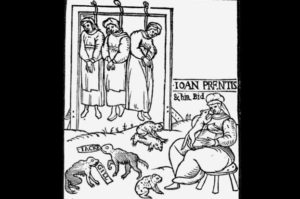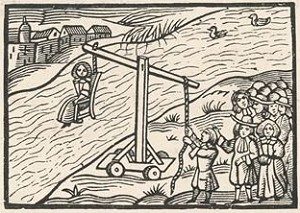As Halloween nears we see the familiar images of evil witches with pointed hats and green skin everywhere. Society, though, has not always been so light-hearted towards the idea witchcraft and magic. Witchcraft became a crime in most countries from about 1450 – 1780 and around 100,000 people across Europe were accused of witchcraft. About 40 Р50,000 were executed. In England, for example, witchcraft became a crime in 1542. The statute was later replaced with the 1563 “Act Against Conjurations, Enchantments and Witchcrafts”. The penalty for witchcraft was hanging or burning at the stake Рdepending on which country you lived in. Many people were tortured into confessions, or naming others before being found guilty.
Witchcraft was believed to be the practice of harmful magic on others. This could be bewitching someone, cursing those who have wronged you, or bringing misfortune to an entire community. It was also believed that witches worshipped the devil and many were accused of making a face-to-face pact with him to get revenge. In some places, it was thought that witches gathered together for ‚ÄúSabbaths‚Äù to worship the devil. Witch hunters were employed to catch those involved in such deeds. Whilst on hunts, witch hunters would often resort to conducting ‚Äòtests‚Äô in an attempt to determine whether an individual was a witch or not. These ranged from plunging an individual into water to see if they would sink or swim through to forcing those accused to recite the Lord‚Äôs Prayer without mistakes.¬† Those accused could face other tests like an examination for ‚Äúthe Devil‚Äôs Mark‚Äù, or touching the victim’s hand to see how they would react. It was not uncommon for witch hunters to use a variety of methods in combination to these ‚Äúwitch tests‚Äù so as to entice confessions out of victims. These included whipping stocks with iron spikes, scalding lime baths, and the rack.
Neither were all witches women, some were men. Yet, due to the belief that women were morally and spiritually weaker than men, they were often accused of witchcraft far more. In fact, 70 – 80% of those accused of witchcraft across Europe were women. The majority of these women would be poor, elderly and/or widowed, who were socially isolated from their neighbours. Some women accused of witchcraft were midwives, who would often be suspected of causing deliberate harm to an infant. Perhaps the reason for these women to be accused so rashly was that they acted as scapegoats for communities. They worked outside the normal parameters of social expectations and went against accepted social conventions of the time.
For more on witches and witch hunting, check out¬†15 Minute History‘s podcast on¬†Witch-hunting in Early Modern Europe.
-Claire Amundson
Junior Girl
Girl Museum Inc.


